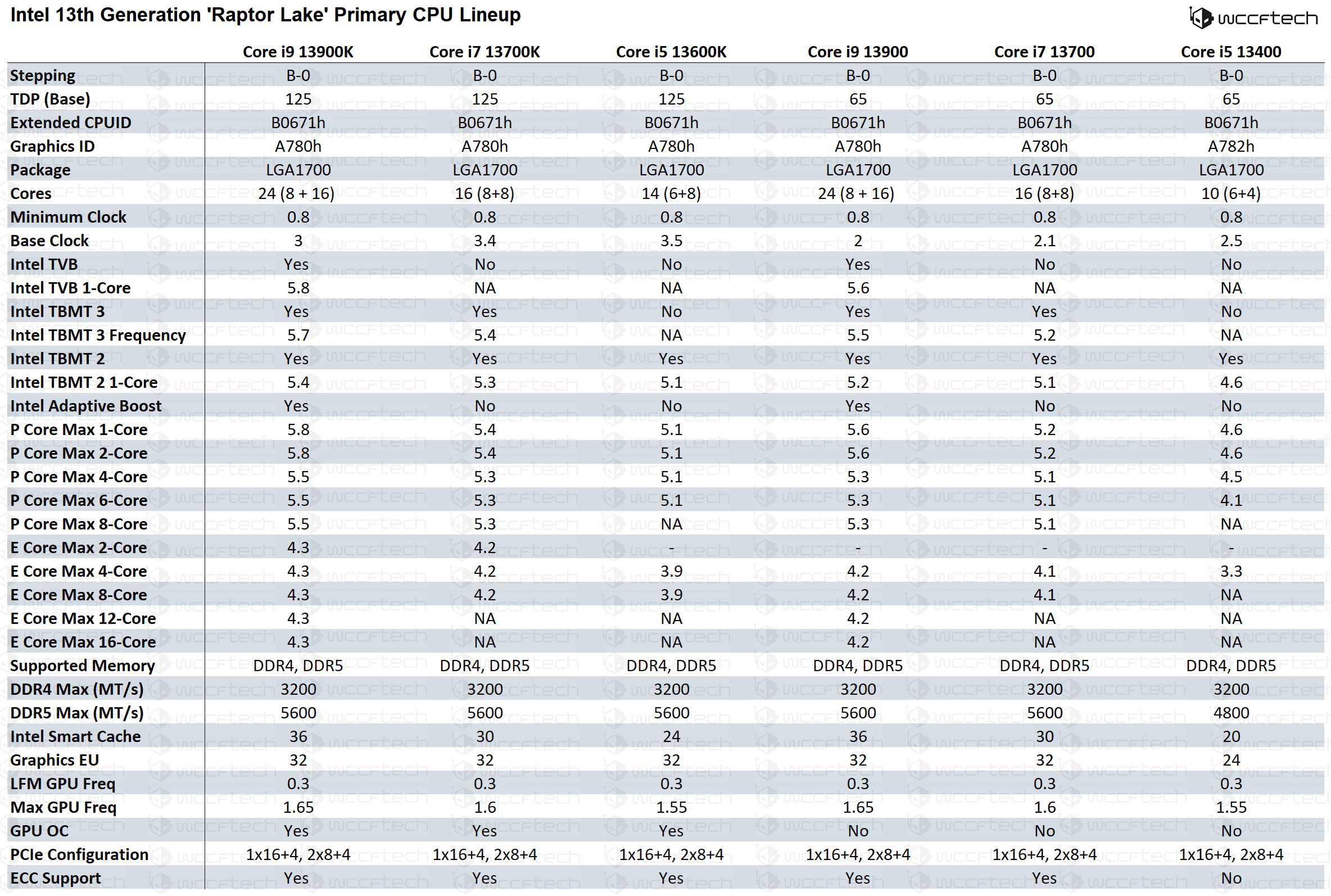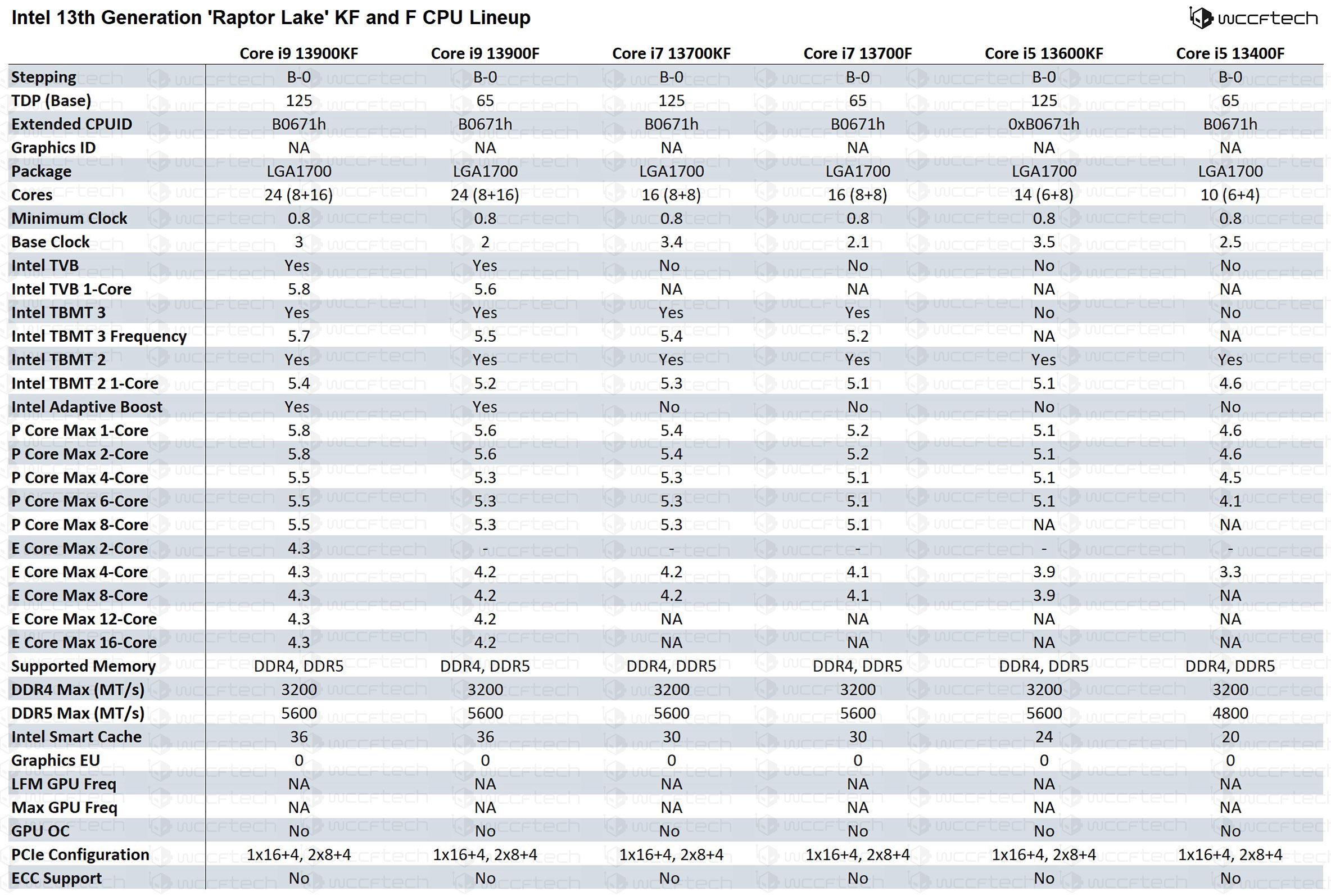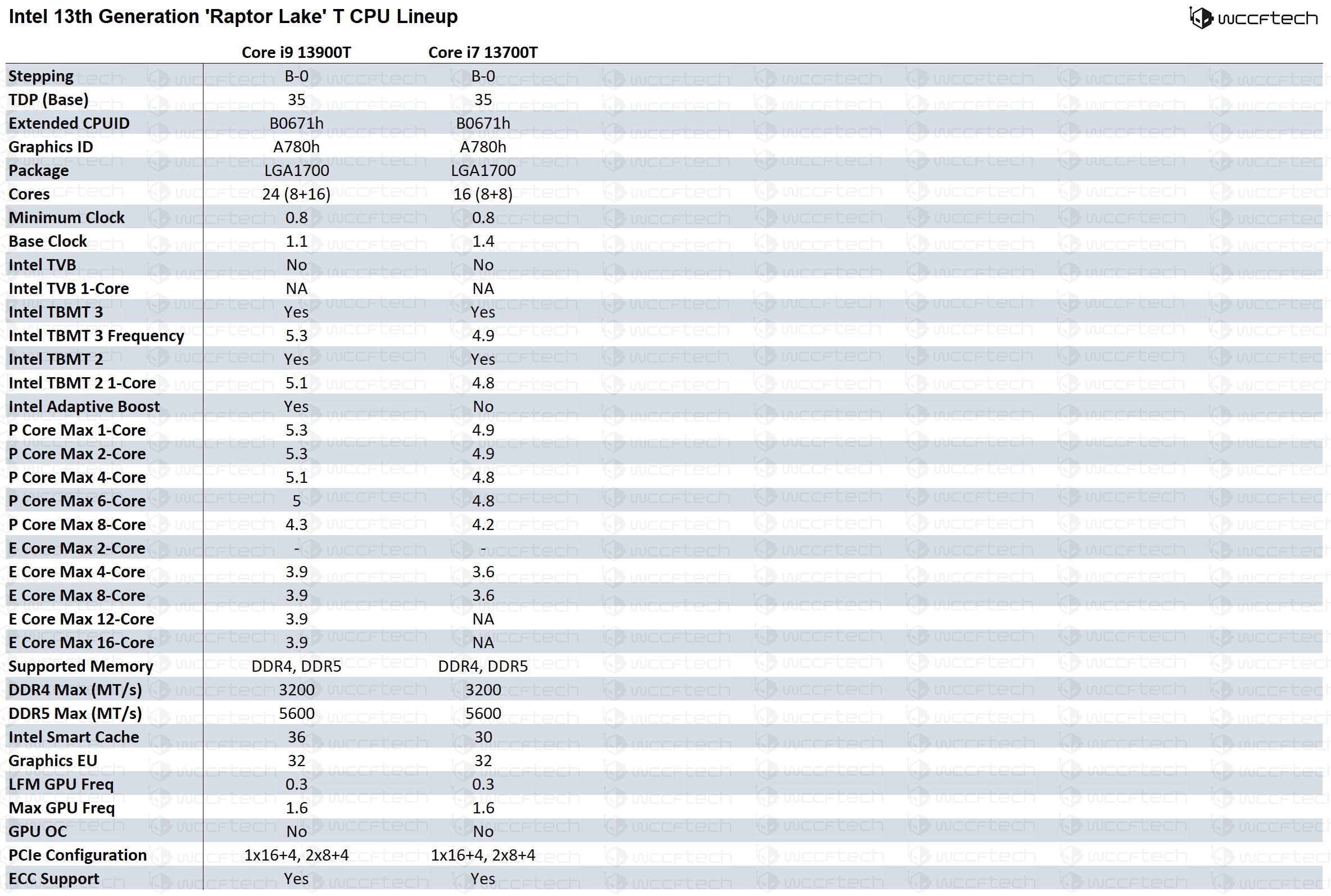Detailed specs, detailed boost clock speeds and more about Raptor Lake processors
Lots of info has already leaked about 125W Raptor Lake processors that Intel is abotu to launch on October 20 as the 13th-generation Core for desktop. The leaked specs were not complete, however. Now, we have a document that clarifies virtually everything – the clock speeds of little cores, details of various boost clocks for different numbers of active cores. And even specs of some 65W and 35W models.
The document that has been published by WCCFtech shows the parameters of each processor. Almost everything is listed in them with one exception – PL2 or Maximum Turbo Power, i.e. the actual limit of processor power draw under load. Intel lists only TDP, which the processors will probably be exceeding substantially, once again.
On the other hand, there are some models described in this document that are not part of the first batch of 125W processors that we already knew about. The charts also list 65W Core i7 and i9 models, and even specs for the Core i5-13400, which may be one of the most popular models, and even 35W i9 and i7 models (35W in terms of TDP, their maximum power draw in boost will probably be many times higher).
Boosts for different numbers of active cores, TVB and TBM 3.0, Adaptive Boost
Raptor Lake will again have complicated boost modes with different levels. For the Core i9-13900K with eight big and 16 little cores, it will be the most complex. The processor has a base clock speed of 3.0 GHz on its big cores, and they can all run simultaneously at up to 5.4 GHz under the base Turbo Boost 2.0 mode.
According to Intel, Core i9 models also have the new Adaptive Boost that Intel introduced with Rocket Lake (while the following Alder Lake didn’t have it). Adaptive Boost is probably the reason why the clock speed limit for Turbo Boost 2.0 doesn’t seem to vary by the number of cores under load. Normally, Intel’s maximum boost does vary according to the number of cores under load.
Read more: Intel Core i9 “Rocket Lake” processors bring a new kind of turbo: Adaptive Boost Technology
In addition, the processor has Turbo Boost Max 3.0 technology. If it’s enabled (and there’s no reason it shouldn’t be), then it’s possible to achieve a clock speed of 5.7 GHz, 300 MHz more than the normal Turbo Boost 2.0, on preferred cores (which refers to those that can handle a higher clock speed). This is only possible on those cores that are preferred (there are two, so a maximum of two cores at a time). Thus, the operating system needs to know which ones they are and adjust the scheduling. These days, both Linux and Windows 10 and 11 should be able to do this since long ago.
What’s more, the Thermal Velocity Boost technology is used. This adds 100 MHz on top of the previous limits if the processor temperature is below a certain threshold (it used to be 70 °C, but we don’t know if this will stay unchanged for Raptor Lake). So if the temperature is low, triggering TVB, the clock speed will be increased to 5.8 GHz if there are at most two (preferred) cores active, or to 5.5 GHz if there are more active cores (three to all eight). In other words, if you’re interested in an “all-core boost,” then it’s 5.4 GHz or 5.5 GHz at a temperature lower than the TVB threshold. Or at least in theory – it could also be that at that clock speed the processor would already exceed the specified Maximum Turbo Power limit, and due to that it would only reach slightly lower clock speeds. Unless these power limits are turned off by the board’s BIOS, which often happens…
The little E-Core cores have simplified operation in Raptor Lake compared to Alder Lake. They are not affected by Thermal Velocity Boost and their maximum clock speed for all 16 cores is the same as for a single active E-Core. For the Core i9-13900K, their maximum boost is 4.3GHz.
The Core i9-13900 with only 65W TDP has the same 8 P-Cores and 16 E-Core cores. However, the clock speeds are lower, especially the base, which is only 2.0 GHz. The Core 9-13900 uses all the boost modes present in the i9-13900K, including Adaptive Boost, but has all clock speeds roughly 200 MHz lower. The maximum Turbo Boost 2.0 clock speed for all big cores active is 5.2 GHz, and 5.3 GHz with Thermal Velocity Boost active. With a load of one or two cores and under the condition of using the preferred cores (i.e. with Turbo Boost Max 3.0), the clock speed can be as high as 5.5 GHz. And if the temperature allows, then again Thermal Velocity Boost can be applied, adding to the final 5.6 GHz.
The maximum clock speed of the little E-Cores is 4.2 GHz, and again it is the same regardless of whether all 16 cores are under load or just one or two. It is more than likely that with this 65W model, when loading all 24 cores to their maximum all-core boosts, the power draw will not ever come remotely near 65 W. So the real top boost clocks will probably depend on what power limits (Maximum Turbo Boost aka PL2) the motherboard allows and possibly for how long (the so-called Tau time, after which the power draw should be reduced to the TDP level, 65 W here).

Core i7
The Core i7-13700K with eight big and eight little cores will have it easier in that it no longer has Thermal Velocity Boost. Also, no models lower than the i9 have Adaptive Boost. Intel states that for the 125W Core i7-13700K model, the base clock speed of the big cores is 3.4 GHz and the maximum (Turbo Boost 2.0) for all cores active is 5.3 GHz. On the two preferred cores, the processor can then go a little higher, to 5.4 GHz. It’s interesting that the difference between single-core and all-threaded workloads is so small. The maximum boost clock on the E-Cores is 4.2 GHz and is the same regardless of the number of cores under load.
The 65W Core i7-13700 has a base clock speed of only 2.1 GHz. Its boost is more or less the same with all clock speeds being 200 MHz lower. Thus, for all P-Cores the limit is 5.1 GHz and if a maximum of two (preferred) are under load, the CPU reaches a clock speed of 5.2 GHz. Little E-Cores have a maximum clock speed of 4.1 GHz regardless of the number of ones under load.
Core i5
The boost is probably simplest with the Core i5-13600K (which is a 14-core with 6 P-Core, 8 E-Core). It has neither Thermal Velocity Boost nor Turbo Boost Max 3.0 or preferred cores. According to the leaked specs, it can simply boost to a maximum of 5.1 GHz on P-Cores, and it doesn’t matter if it’s on one or all six that it has (even though it’s said it can’t do Adaptive Boost). Its base clock speed is 3.5 GHz. It then supports a maximum clock speed of 3.9 GHz on all eight of its E-Cores.
Core i5-13400: will the popular one come out now in autumn?
Ironically, things may be more complicated with the 65W models. Intel lists specs for the Core i5-13400, which should be the cheapest i5 model and will probably be the choice of a large number of customers (it has only 6 big and 4 little cores instead of 6+8, i.e. 6+4). Its base clock speed is supposed to be only 2.5 GHz. Its four E-Cores have a maximum boost of 3.3 GHz, and in the case of P-Cores, with one or two active it can run at up to 4.6 GHz (that’s its absolute maximum), with three or four active it can run at 4.5 GHz, but if five or six P-Cores are under load, then the maximum is only 4.1 GHz (which might degrade gaming performance a bit).
Uncertainty in the silicon used
The Core i5-13400 may be worth a brief further pause. According to previous reports, this model should already be based on the C-0 die, while the Core i9, i7 and 125W i5 models are expected to be B-0 die. And according to some leaks, the C-0 die may not even be Raptor Lake architecture anymore, but a rebranded Alder Lake silicon (this is not yet confirmed, it may be a mistaken information), which would mean that P-Core cores would not have 2 MB L2 cache and E-Core clusters 4 MB L2 cache, but only 1.25 MB and 2 MB as in Alder Lake. But now leaked specs say that the Core i5-13400 is still based on the B-0 die, i.e. Raptor Lake.
However, they also say that the supported memory speed is reduced to only DDR5-4800, which is where it was with Alder Lake dies, while the other processors in the charts can do DDR5-5600 (incidentally that is better than what Ryzen 7000, for which only DDR5-5200 is officially listed, can do).
Nonetheless, we can offer one possible (speculative) explanation – Intel used to produce the 400 models in multiple variants, and that could happen here as well. There would be a version with B-0 silicon that would use defective chips not suitable for higher models, and that’s what you see in the chart here. Then later next year, versions based on the smaller C-0 silicon would hit the market. It’s quite possible that the C-0s will have paste under the IHS, whereas the B-0s will be soldered because Intel is building 125W unlocked versions on that silicon. But on the other hand, the C-0 version could have lower power draw. If this is confirmed, and at the same time the C-0 dies are in fact refreshed Alder Lake silicon, then what could probably happen though, is that Intel could deactivate part of the L2 cache for the B-0 versions so that both versions of the Core 5-13400 have the same capacities.
Read More: The same and yet different. Intel Core i5-12400 duel (H0 vs. C0)

It’s actually interesting that these 65W models are already featured in the specifications. It would be welcome if Intel released them in the first batch of processors instead of it being limited to 125W models. Previously, Intel has been releasing at least one low-cost multiplier-locked model like this (Core i5-8400, i5-9400, and the 9400F model), which might give some hopes that perhaps an i5-13400 model could be on sale in October. But other sources have so far talked about 65W models coming out only later, in Q1 2023.
Integrated GPU
We also have new information about integrated graphics. It has the same number of units as in the desktop Alder Lake, i.e. 256 shaders (32 EU). Its bottom clock speed is 300 MHz, and the maximum clock speed under graphical load is 1550 MHz (for Core i5 SKUs), 1600 MHz (Core i7) or up to 1650 MHz (for the highest-end Core i9 processors). Similarly to the previous generation, the Core i5-13400 as a low-cost model has slightly trimmed graphics, instead of 32 EUs, only 24 are enabled (192 shaders). The GPU can be overclocked, by the way, but this is only allowed on the enthusiast 125W “K” models.
Models without GPU (and without ECC)
The charts confirm that Intel will also offer GPU-deactivated models again, which will be slightly cheaper. These models will be derived from all 125W models, so there will be Core i9-13900KF, Core i7-13700KF and Core i5-13600KF. The specs will be the same as on the K models in all individual details (except for the GPU). Furthermore the non-graphics versions will exist in the 65W class as well. The leaked tables confirm the existence of Core i9-13900F, Core i7-13700F and Core i5-13400F models. Their specifications are again exactly the same as the non-F models (13900, 13700, 13400 and so on).

Or rather – there is one difference. The KF and F models will probably be left out of vPro support again. Because of this, they also do not support ECC memory, unlike the base models with GPUs that do. The exception is the Core i5-13400, which does not support vPro and ECC even in its base version with GPU. Note: ECC memory can only be used with a special board, such as one with the W680 chipset.
35W models
Much as precious generations did, Raptor Lake is also supposed to provide 35W models (although Maximum Turbo Power will probably be many times higher). There will probably be more SKUs in the end, but so far two have appeared in the leaked charts. The Core i9-13900T will have eight big and 16 little cores and a base clock speed of just 1.1 GHz. The maximum clock speed of the E-Cores is 3.9 GHz, while the P-Cores have different clock speeds depending on the number of cores under load (Intel states that Adaptive Boost is available, but the specifications don’t look like it at all). Up to 5.3 GHz is possible on one or two preferred cores (Turbo Boost Max 3.0), 5.1 GHz will be possible with three or four cores, only 5.0 GHz with five or six, and the limit drops sharply to 4.3 GHz with seven or eight active P-Cores.
The Core i7-113700T will have 8 big and 8 little cores, just like the higher-power version, but the base clock speed is only 1.4 GHz. On E-Cores, the maximum will be 3.6 GHz, on P-Cores it again depends on the number of cores under load. Up to 4.9 GHz is possible on one or two preferred cores (Turbo Boost Max 3.0), with three to six cores 4.8 GHz will be possible, with seven or eight the limit drops sharply to 4.2 GHz.

With these models, the lack of knowledge of the maximum turbo power draw figure is expecially limiting, as the PL2/maximum turbo power will be the main performance (boost clocks) bottleneck under load. It’s quite possible that just one core running at 5.3 GHz on the i9-13900T will develop enough power draw to go over 35 W. In the Alder Lake generation these 35W models had maximum turbo power draw of 106 W and 99 W (at lower clock speeds than these 13th gen models have), but that still might not be enough to maintain the all-core boosts listed in the table for P-Cores and E-Cores at the same time.
Source: WCCFtech
English translation and edit by Jozef Dudáš
⠀⠀








